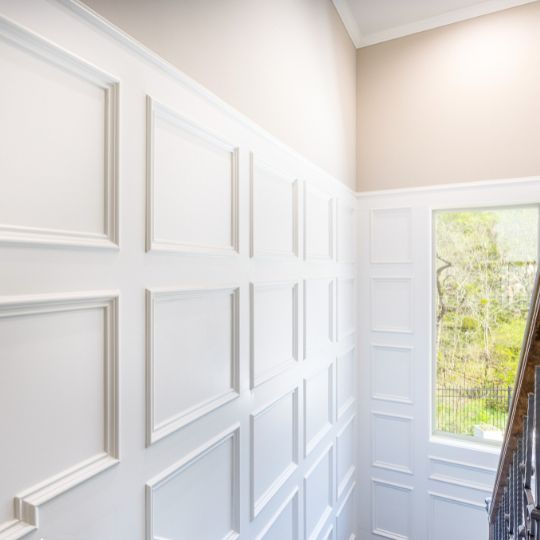Wainscoting is one of those timeless design elements that adds character, texture, and elegance to any room. Its roots trace back centuries, originally used as a form of wall protection against scuffs and dampness. Today, it’s a hallmark of both classic and contemporary home decor. But did you know there are different types of wainscoting, each offering a unique style and aesthetic? In this guide, we’ll dive into the most popular types of wainscoting and how to choose the right one for your space.
Types of Wainscoting for Your Home
1. Raised Panel Wainscoting
Raised panel wainscoting is the most traditional and formal style. It dates back to the 17th century and is commonly found in colonial-style homes. The hallmark of this type is the raised, beveled panels set within a framework of rails and stiles, creating a three-dimensional effect. This style adds depth and a sense of luxury to rooms like dining areas, foyers, or formal living rooms.
Best for: Traditional, formal interiors or spaces you want to give a high-end feel.
Tip: Pair it with crown molding for an ultra-refined look.
2. Flat Panel Wainscoting (Shaker Style)
Flat panel wainscoting, also known as Shaker wainscoting, is all about simplicity. It features flat panels set behind the rails and stiles, creating a clean and minimalist look. The lack of ornate detailing makes it perfect for homes with modern, farmhouse, or transitional decor. It’s a versatile style that can be used in almost any room, offering subtle texture without overwhelming the space.
Best for: Modern, Scandinavian, and farmhouse interiors.
Tip: Opt for white or light gray paint to keep the minimalist aesthetic fresh and airy.
3. Beadboard Wainscoting
Beadboard wainscoting is one of the more casual and approachable styles. It features narrow vertical planks (or tongue-and-groove boards) with grooves between each plank, creating a lined texture. This style has a charming, cottage-like feel and works beautifully in kitchens, bathrooms, and even as a ceiling treatment.
Best for: Coastal, cottage, or casual farmhouse decor.
Tip: Beadboard is excellent in high-moisture areas like bathrooms, as the vertical lines can help elongate the walls and make the space feel taller.
4. Board and Batten Wainscoting
Board and batten wainscoting is characterized by vertical panels (or boards) with thin strips of wood (battens) placed over the seams. This style has a rugged, architectural quality and is often associated with Craftsman or farmhouse design. It adds an element of texture and interest to the walls without being too busy.
Best for: Craftsman, rustic, or industrial interiors.
Tip: You can experiment with the spacing of the battens to create custom looks, or try painting it in bold, dark hues for a dramatic effect.
5. Overlay Wainscoting
Overlay wainscoting is a combination of flat panel wainscoting with additional molding layered on top to create the appearance of raised panels. This style offers the depth and elegance of raised panel wainscoting but with a more customizable approach. You can create any number of designs by varying the shapes and sizes of the panels.
Best for: Transitional or eclectic spaces that blend traditional and contemporary elements.
Tip: Since it’s customizable, overlay wainscoting is a great way to get creative with unique panel designs that complement the architecture of your home.
6. Picture Frame Wainscoting
Also known as “frame and panel” wainscoting, picture frame wainscoting is a less formal alternative to raised or flat panel wainscoting. It features thin molding applied directly to the wall in rectangular patterns, mimicking the appearance of panels. This style works well in more casual spaces, offering a touch of refinement without being overly traditional.
Best for: Transitional, contemporary, and eclectic homes.
Tip: You can customize the frame sizes to add a dynamic, geometric feel to your walls.
7. Vinyl Wainscoting
For homes that need a more practical solution, vinyl wainscoting is a modern alternative to traditional wood. It’s typically found in bathrooms, kitchens, or mudrooms, where durability and water resistance are key. Vinyl wainscoting mimics the look of beadboard or board and batten, but it’s much easier to maintain in high-traffic or moisture-prone areas.
Best for: Utility spaces, bathrooms, and areas where moisture is a concern.
Tip: Vinyl wainscoting can often be painted to match your décor, offering flexibility with the durability you need.
Choosing the Right Wainscoting for Your Home
When deciding which wainscoting style is right for your space, consider both the architectural style of your home and the room’s function. Raised panel wainscoting can transform a formal dining room into a grand, stately space, while beadboard can make a bathroom feel cozy and inviting.
Additionally, think about the height of your wainscoting. Traditionally, it covers the bottom third of the wall, but going taller can add drama, especially in spaces with high ceilings. Play with color as well—white and light hues keep things classic, but deeper tones can bring in a sense of modern sophistication.
Wainscoting is a powerful design element that has stood the test of time, offering both function and aesthetic appeal. Whether you’re drawn to the elegance of raised panels, the rustic charm of board and batten, or the cozy feel of beadboard, there’s a wainscoting style to match your taste and enhance your home’s interior. The right type can elevate your walls from flat to fabulous, adding a layer of sophistication that will never go out of style.
Have you used wainscoting in your home decor? Let us know which style you chose and how it transformed your space!

